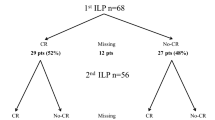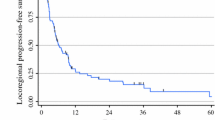Abstract
Background
Isolated limb perfusion (ILP) and infusion (ILI) are therapeutic modalities for the treatment of in transit melanoma.
Methods
A retrospective review of all patients undergoing first-time ILI or ILP for in-transit melanoma metastases between 2007 and 2015 was performed. Demographic and clinical characteristics included age, sex, nodal status at the time of ILI/ILP (N-stage), and burden of disease (BOD). Regional toxicity was categorized by the Wieberdink classification. Clinical response was evaluated at 3 months after treatment.
Results
A total of 203 patients were reviewed (ILI = 94, ILP = 109). There were no differences in age, sex, or N-stage between groups; however, BOD was higher for the ILI group (high BOD 58 vs. 44 %, p = 0.04). Regional toxicity was minimal (Grade IV < 1 % in ILI and 2 % in ILP, p = 0.40). Overall response rate (ORR) was 53 % for ILI versus 80 % for ILP (p < 0.001). Median overall survival (OS) was 46 months for ILI versus 40 months for ILP (p = 0.31). A high BOD [hazard ratio (HR) 3.02, 95 % confidence interval (CI) 1.85–4.93, p < 0.001] and N3 disease (HR 1.58, 95 % CI 1.01–2.48, p = 0.04) were associated with worse OS, whereas there was no difference in OS by procedure (p = 0.20).
Conclusion
ILP offers an improved ORR, but this does not translate into improved local PFS or OS. Both procedures are well tolerated with minimal regional toxicity.

Similar content being viewed by others
References
Teh MT, Blaydon D, Chaplin T, Foot NJ, Skoulakis S, Raghavan M, et al. Genomewide single nucleotide polymorphism microarray mapping in basal cell carcinomas unveils uniparental disomy as a key somatic event. Cancer Res. 2005;65(19):8597–603. doi:10.1158/0008-5472.can-05-0842.
Rusthoven JJ, Quirt IC, Iscoe NA, McCulloch PB, James KW, Lohmann RC, et al, National Cancer Institute of Canada Clinical Trials Group. Randomized, double-blind, placebo-controlled trial comparing the response rates of carmustine, dacarbazine, and cisplatin with and without tamoxifen in patients with metastatic melanoma. J Clin Oncol. 1996;14(7):2083–90.
Read RL, Haydu L, Saw RP, Quinn MJ, Shannon K, Spillane AJ, et al. In-transit melanoma metastases: incidence, prognosis, and the role of lymphadenectomy. Ann Surg Oncol. 2015;22(2):475–81. doi:10.1245/s10434-014-4100-0.
Balch CM, Gershenwald JE, Soong SJ, Thompson JF, Atkins MB, Byrd DR, et al. Final version of 2009 AJCC melanoma staging and classification. J Clin Oncol. 2009;27(36):6199–206. doi:10.1200/JCO.2009.23.4799.
Abbott AM, Zager JS. Locoregional therapies in melanoma. Surg Clin North Am. 2014;94(5):1003–15. doi:10.1016/j.suc.2014.07.004.
Gabriel E, Skitzki J. The role of regional therapies for in-transit melanoma in the era of improved systemic options. Cancers (Basel). 2015;7(3):1154–77. doi:10.3390/cancers7030830.
Olofsson R, Mattsson J, Lindner P. Long-term follow-up of 163 consecutive patients treated with isolated limb perfusion for in-transit metastases of malignant melanoma. Int J Hyperth. 2013;29(6):551–7. doi:10.3109/02656736.2013.802374.
Kroon HM, Huismans AM, Kam PC, Thompson JF. Isolated limb infusion with melphalan and actinomycin D for melanoma: a systematic review. J Surg Oncol. 2014;109(4):348–51. doi:10.1002/jso.23553.
Raymond AK, Beasley GM, Broadwater G, Augustine CK, Padussis JC, Turley R, et al. Current trends in regional therapy for melanoma: lessons learned from 225 regional chemotherapy treatments between 1995 and 2010 at a single institution. J Am Coll Surg. 2011;213(2):306–16. doi:10.1016/j.jamcollsurg.2011.03.013.
Beasley GM, Petersen RP, Yoo J, McMahon N, Aloia T, Petros W, et al. Isolated limb infusion for in-transit malignant melanoma of the extremity: a well-tolerated but less effective alternative to hyperthermic isolated limb perfusion. Ann Surg Oncol. 2008;15(8):2195–205. doi:10.1245/s10434-008-9988-9.
OlofssonBagge R, Mattsson J, Hafstrom L. Regional hyperthermic perfusion with melphalan after surgery for recurrent malignant melanoma of the extremities–long-term follow-up of a randomised trial. Int J Hyperthermia. 2014; 30(5):295–8. doi:10.3109/02656736.2014.931601.
Kroon HM, Lin DY, Kam PC, Thompson JF. Safety and efficacy of isolated limb infusion with cytotoxic drugs in elderly patients with advanced locoregional melanoma. Ann Surg. 2009;249(6):1008–13. doi:10.1097/SLA.0b013e3181a77ce5.
Muilenburg DJ, Beasley GM, Thompson ZJ, Lee JH, Tyler DS, Zager JS. Burden of disease predicts response to isolated limb infusion with melphalan and actinomycin D in melanoma. Ann Surg Oncol. 2015;22(2):482–8. doi:10.1245/s10434-014-4072-0.
Kroon HM, Moncrieff M, Kam PC, Thompson JF. Outcomes following isolated limb infusion for melanoma. A 14-year experience. Ann Surg Oncol. 2008;15(11):3003–13. doi:10.1245/s10434-008-9954-6.
Moreno-Ramirez D, de la Cruz-Merino L, Ferrandiz L, Villegas-Portero R, Nieto-Garcia A. Isolated limb perfusion for malignant melanoma: systematic review on effectiveness and safety. Oncologist. 2010;15(4):416–27. doi:10.1634/theoncologist.2009-0325.
Beasley GM, Caudle A, Petersen RP, McMahon NS, Padussis J, Mosca PJ, et al. A multi-institutional experience of isolated limb infusion: defining response and toxicity in the US. J Am Coll Surg. 2009;208(5):706–15; discussion 15-7. doi:10.1016/j.jamcollsurg.2008.12.019.
Wieberdink J, Benckhuysen C, Braat RP, van Slooten EA, Olthuis GA. Dosimetry in isolation perfusion of the limbs by assessment of perfused tissue volume and grading of toxic tissue reactions. Eur J Cancer Clin Oncol. 1982;18(10):905–10.
Eisenhauer EA, Therasse P, Bogaerts J, Schwartz LH, Sargent D, Ford R, et al. New response evaluation criteria in solid tumours: revised RECIST guideline (version 1.1). Eur J Cancer. 2009;45(2):228–47. doi:10.1016/j.ejca.2008.10.026.
Hodi FS, O’Day SJ, McDermott DF, Weber RW, Sosman JA, Haanen JB,et al. Improved survival with ipilimumab in patients with metastatic melanoma. N Engl J Med. 2010;363(8):711–23. doi:10.1056/NEJMoa1003466.
Robert C, Thomas L, Bondarenko I, O’Day S, Weber J, Garbe C,et al. Ipilimumab plus dacarbazine for previously untreated metastatic melanoma. N Engl J Med. 2011;364(26):2517–26. doi:10.1056/NEJMoa1104621.
Robert C, Ribas A, Wolchok JD, Hodi FS, Hamid O, Kefford R, et al. Anti-programmed-death-receptor-1 treatment with pembrolizumab in ipilimumab-refractory advanced melanoma: a randomised dose-comparison cohort of a phase 1 trial. Lancet. 2014;384(9948):1109–17. doi:10.1016/S0140-6736(14)60958-2.
Sosman JA, Kim KB, Schuchter L, Gonzalez R, Pavlick AC, Weber JS,et al. Survival in BRAF V600-mutant advanced melanoma treated with vemurafenib. N Engl J Med. 2012;366(8):707–14. doi:10.1056/NEJMoa1112302.
Hauschild A, Grob JJ, Demidov LV, Jouary T, Gutzmer R, Millward M, et al. Dabrafenib in BRAF-mutated metastatic melanoma: a multicentre, open-label, phase 3 randomised controlled trial. Lancet. 2012;380(9839):358–65. doi:10.1016/S0140-6736(12)60868-X.
Wong J, Chen YA, Fisher KJ, Beasley GM, Tyler DS, Zager JS. Resection of residual disease after isolated limb infusion (ILI) is equivalent to a complete response after ILI-alone in advanced extremity melanoma. Ann Surg Oncol. 2014;21(2):650–5. doi:10.1245/s10434-013-3336-4.
Testori A, Verhoef C, Kroon HM, Pennacchioli E, Faries MB, Eggermont AM, et al. Treatment of melanoma metastases in a limb by isolated limb perfusion and isolated limb infusion. J Surg Oncol. 2011;104(4):397–404. doi:10.1002/jso.22028.
Disclosures
None.
Author information
Authors and Affiliations
Corresponding author
Additional information
Lesly A. Dossett and Ilan Ben-Shabat have contributed equally to this work.
Rights and permissions
About this article
Cite this article
Dossett, L.A., Ben-Shabat, I., Olofsson Bagge, R. et al. Clinical Response and Regional Toxicity Following Isolated Limb Infusion Compared with Isolated Limb Perfusion for In-Transit Melanoma. Ann Surg Oncol 23, 2330–2335 (2016). https://doi.org/10.1245/s10434-016-5150-2
Received:
Published:
Issue Date:
DOI: https://doi.org/10.1245/s10434-016-5150-2




